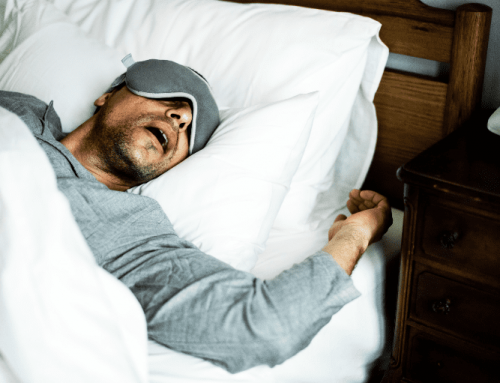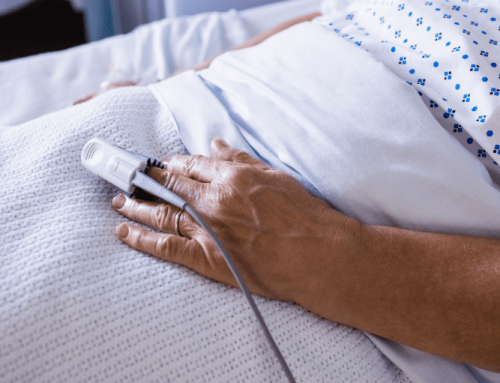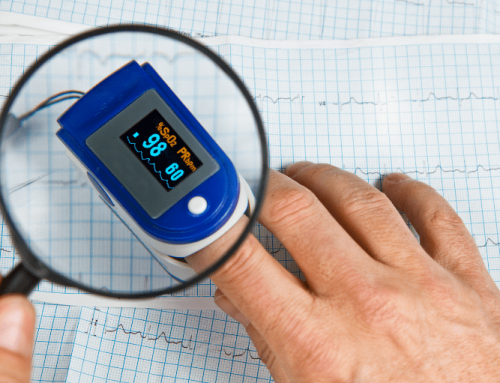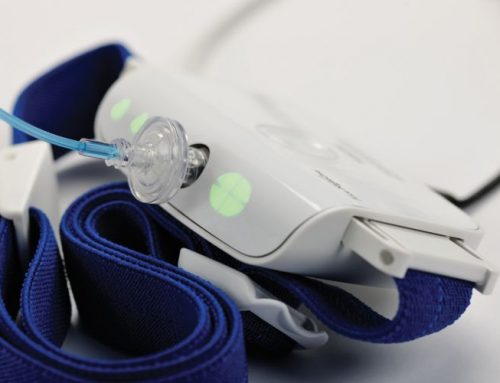Overnight Oximetry to Test for Low Oxygen Levels
Overnight pulse oximetry is an easy way to measure the amount of oxygen circulating in the blood throughout the night while an individual is sleeping. To understand how pulse oximetry works, we must first understand how our body distributes oxygen from the lungs to other vital organs. After breathing in, red blood cells circulating by the lungs pick up and carry the inhaled oxygen throughout our body to our cells, tissues, and organs. This process is necessary to keep our bodies healthy and functioning the way it’s supposed to. If there were to be a circumstance that interrupts this process, oxygen levels may fall. If the lungs cannot replace the missing oxygen and these levels do not return to normal quickly, the organs will not receive the nutrients needed and can suffer damage within a few minutes. Therefore, it is crucial that our bodies are always taking in the necessary amount of oxygen, even while sleeping.
While it is normal for oxygen levels to drop slightly while asleep, if levels fall significantly below normal for an extended time, or multiple times a night, it can result in restlessness, snoring, fatigue, weakness, lack of energy, and elevated blood pressure.
If your physician suspects you may have a disorder that impedes your body’s ability to take in adequate oxygen, like COPD or sleep apnea, they may recommend a sleep test called an overnight oximetry test. An overnight oximetry test is performed using a pulse oximeter. The pulse oximeter is placed on a finger and connects to a device that continuously records heart rate and oxygen saturation levels while asleep. A pulse oximeter works by emitting an infrared light into the capillaries in the finger, a sensor then detects the amount of light reflected off the gases in the blood. A percentage then indicates the amount of blood that is saturated with oxygen. The data recorded is displayed as a graph and shows any significant decreases in oxygen levels overnight and the frequency of disrupted sleep. Normal oxygen saturation levels while sleeping range from 90%-100%. Anything reading at or below 88% would indicate an abnormal drop in oxygen levels, called desaturations. If oxygen levels fall and remain at a lower level for any significant amount of time, it could indicate potential heart or lung conditions. Overnight oximetry testing is beneficial in detecting these events so a physician can administer the proper treatment.
Reasons to Pursue OPO:
- Being diagnosed with or monitoring a known heart or lung condition that could affect oxygen levels.
- History of smoking, chronic bronchitis, pneumonia or asthma, asbestosis, or any form of chronic obstructive pulmonary disease (COPD).
- Symptoms such as shortness of breath, headaches, fatigue, daytime drowsiness, or disrupted sleep.
- Diagnose if breathing slows or stops while asleep.
- Determine the need for home sleep testing due to suspected obstructive sleep apnea.
- Monitor supplemental oxygen treatments to determine if oxygen levels are within normal limits or need to be adjusted.
- Initial evaluation to screen for home oxygen therapy.
If you are uncertain whether you should consider an overnight pulse oximetry test, you can start by taking Vitalistics’ free online sleep assessment. This assessment will show if you have any risk factors for sleep-disordered breathing. You can then take the results of this assessment to your physician to discuss whether or not you would benefit from overnight pulse oximetry testing. If your physician believes testing would be beneficial, or you may require oxygen therapy, they can order the test through the Vitalistics’ website. Once your physician orders the test, Vitalistics will send the pulse oximeter directly to your home so you can perform the test in the comfort of your own bed. Detailed instructions are provided, so the test is performed correctly, and the results are accurate. After wearing the pulse oximeter overnight, you will return the device to Vitalistics for processing. Once the results are available, your physician will immediately receive a detailed report for review. Your physician will then discuss results with you, recommend the next steps, and determine the best course of treatment if indicated.
Benefits of Overnight Pulse Oximetry Testing:
An overnight pulse oximetry test is a non-invasive, convenient, and cost-effective way to measure your blood oxygen level and pulse while sleeping. And with Vitalistics, you can perform the test yourself in the comfort of your own bed. Results will alert your physician if treatment is needed to increase your oxygen levels with supplemental oxygen, ventilation, or medications. Overall, overnight pulse oximetry is simple, can provide peace of mind for chronic respiratory and cardiovascular patients, initially assess sleep apnea patients, and determine the effectiveness of current breathing treatments. Although overnight pulse oximetry does not provide enough information to adequately diagnose obstructive sleep apnea, it is the preliminary step to determine if additional testing is necessary. If you believe you may benefit from overnight pulse oximetry, begin with our free sleep assessment and speak with your doctor about the next steps to get you sleeping better, to improve your mood, and increase daytime alertness.









